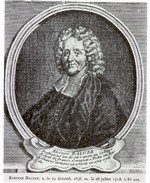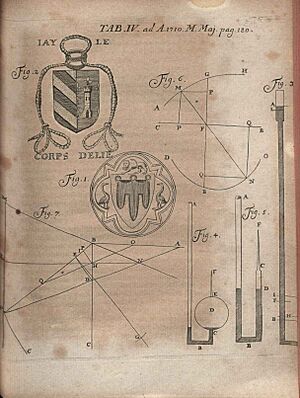Étienne Baluze facts for kids
Quick facts for kids
Étienne Baluze
|
|
|---|---|
 |
|
| Born | 24 November 1630 |
| Died | 28 July 1718 (aged 87) |
| Occupation | Librarian Historiographer |
Étienne Baluze (born November 24, 1630 – died July 28, 1718) was a very important French scholar and historian. He was also known as Stephanus Baluzius. He spent his life studying and writing about history, especially the history of France and the Church.
Contents
Étienne Baluze's Life
Étienne Baluze was born in a town called Tulle in France. He went to school at a Jesuit college in his hometown, where he studied different subjects. When he was 15, he moved to the University of Toulouse. There, he joined a special college called Collège de St. Martial.
Early Career
Baluze became a secretary to Pierre de Marca, who was an archbishop in Toulouse. An archbishop is a very high-ranking leader in the Christian Church. Pierre de Marca really liked Baluze's work. When Marca passed away, he left all his important papers to Baluze.
Baluze then worked to publish Marca's writings. He put together a full version of Marca's book called De libertatibus Ecclesiae Gallicanae in 1663. He also published another of Marca's works, Marca hispanica, in 1688.
Working for Colbert
In 1667, Baluze started working for Jean-Baptiste Colbert. Colbert was a very powerful minister for the King of France, Louis XIV. Baluze was put in charge of Colbert's huge and valuable library. He worked there until 1700, helping to organize and care for countless books and documents.
Colbert was very happy with Baluze's work. He helped Baluze get special jobs and even made him the king's almoner in 1679. An almoner was someone who gave money or help to the poor on behalf of the king.
Later, in 1689, Baluze became a professor of Canon law at the Collège de France. Canon law is a set of rules and laws used by the Catholic Church. He even led the college from 1707 to 1710.
The Auvergne Family History
Baluze became involved in a tricky situation when he was writing about the history of a noble family called the House of Auvergne. A powerful leader, the cardinal de Bouillon, wanted to prove that his family, the La Tour family, was directly related to the very old counts of Auvergne from the 800s.
However, there weren't enough real documents to prove this. So, some people started making up fake documents. This had actually happened before with other historians. A man named Jean de Bar, who was close to the cardinal, organized the creation of these fake papers.
Many famous scholars, including Baluze himself, were asked to check these documents. At first, they all agreed that the papers seemed real in 1695. But the cardinal had many enemies, and soon people started arguing about the documents.
In 1698, Baluze wrote a letter trying to defend the documents, but it didn't really prove anything. Two years later, in 1700, the people who made the fake documents were caught. After a long investigation, it was confirmed in 1704 that the documents were indeed fake.
Even after this, Baluze still believed the documents were real. He decided to publish more books with "proofs," which sadly included the very documents that had been found to be fake. Because of this, he lost favor with the king and was sent away from Paris to Tours in 1710. He lived there until 1713.
Later Years and Death
Even though he was in exile, Baluze kept working. In 1717, he published a history of his hometown, Tulle, called Historiae Tutelensis libri tres. In November 1713, he was allowed to return to Paris. He passed away there on July 28, 1718.
Étienne Baluze's Books
Baluze wrote many important books during his life. Some of his most well-known works include:
- Capitularia Regum Francorum (1677) – This book was about laws and rules from the early French kings.
- Nova Collectio Conciliorum (1683) – A collection of records from Church councils.
- Miscellanea (1678—1715) – A collection of various historical texts and documents.
- Epistolae Innocentii Papae III (1682) – A collection of letters from Pope Innocent III. It wasn't complete because Baluze couldn't get all the letters from the Vatican.
- Vitae Paparum Avenionensium (1693) – This book was about the lives of the Popes who lived in Avignon, France, for a period of time.
- Histoire généalogique de la maison d'Auvergne (1708) – The book about the Auvergne family history that caused some trouble.
- Historia Tutelensis (1716) – His history of Tulle, his hometown.
Honoring Baluze Today
Étienne Baluze is still remembered and honored today.
- In October 2006, a statue of Baluze, made by artist Nacera Kainou, was placed in his hometown of Tulle.
- A special award called the "Étienne Baluze European Local History Prize" was created in 2007. This prize is given to historians who do great work in local history.
- The first prize was given to an Italian historian named Beatrice Palmero in 2008. The President of France, François Hollande, even presented the award!
- The second Baluze prize was given in 2010 to an English historian named Allison Carol.


